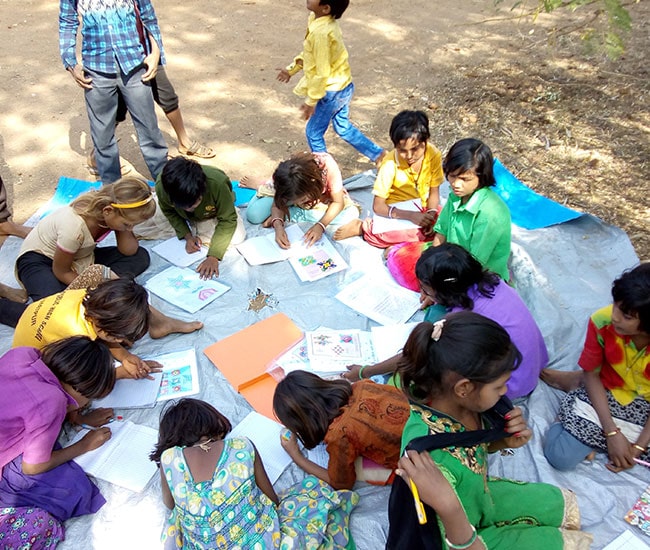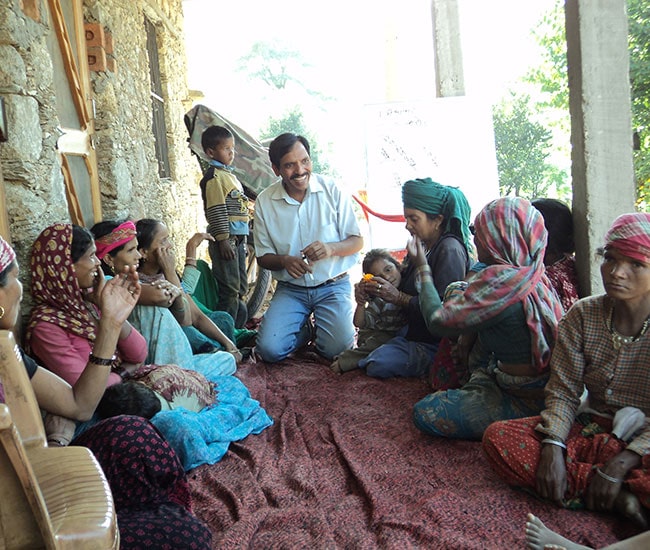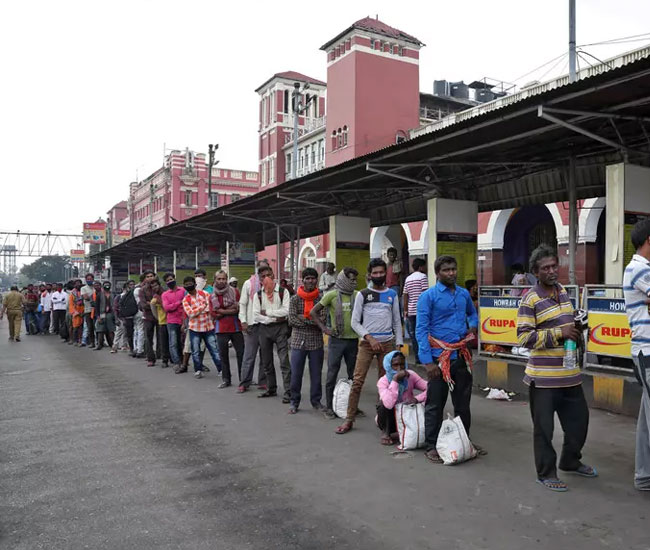
Dilli Shramik Sangathan
Background
The slums in Delhi, as in other urban centres, are clusters of dwellings of poor migrant workers and their families who come to the city to earn a living. In 1982, before the Asian Games, the government brought in 10 lakh (1 million) workers into the city for development and beautification projects. In the following years, migration has been on the rise owing to lack of sources of livelihood in rural areas. While the first master plan for Delhi (made in 1962) included space within the city for the poor, in recent decades, rising real estate prices and changing attitudes and policies of the ruling classes meant that the slum dweller became increasingly vulnerable. While his/her services were still required, his/her right to living space and basic resources was questioned. From 2000-2006, aided by court orders, around 350 slums, many that had been in existence for decades, were demolished in the name of making the city clean and more developed. Meanwhile, the rehabilitation procedure was made so complicated that roughly two thirds of the families were left homeless, the others being given plots in locations very far from their sources of livelihood. A survey done by the Ministry of Housing and Poverty Alleviation in 2011 says that one in five persons living in Delhi is a slum dweller. There are 3,133 slums in the city, 1,058 of them registered, with 31.63 lakh (3.16 million) people living in them.
The Dilli Shramik Sangathan’s work till 2006 was concentrated on empowering people living in slums to claim from government authorities basic amenities and services that they had been deprived of or for which they had been at the mercy of local politicians. In 1991, when Ramendra and Anita started working in the Vikaspuri slums in West Delhi, they found people just did not have any information — they did not know what the minimum daily wage was, or how to get a ration card, who to approach for water supply or how to get their children enrolled into school. They were completely unaware of how to negotiate their way through the multitude of the city’s offices and authorities.
Discussions revealed that what people wanted was to lead a life of dignity and respect and the parameters for measuring these were access to food, water, sanitation and education. Getting children into school was the first major challenge that Ramendra and Anita took on. They along with the representatives of the basti met with and persuaded the authorities to give 500 children admission to the local government schools. (Education for Children) This seemed like a miracle to the people of the bastis and they whole heartedly committed themselves to the process that Ramendra and Anita were trying to initiate, coming together as a group that was later formally registered as the Dilli Shramik Sangathan.
Another major problem faced by the people was their dependence on moneylenders who exploited their poverty and charged exorbitant rates of interest, sometimes going as far as to usurp a person’s tenement in return for an unpaid loan. In 1993, an initiative called Mahila Ekta Kosh was started with women putting in Rs.10 per week into their account to build some kind of savings. This initiative ran successfully for 10-12 years and had a collection of Rs.52 lakhs (5.2 million). Apart from the obvious financial benefits, it also helped in empowering the women and increasing their participation in other aspects of the sangathan’s work.
Efforts were also made simultaneously to get water, electricity and toilets, to deal with corrupt ration dealers, and to resist harassment by the police. In every case, the aim was not just to solve the immediate problem, but to create awareness about urban governance — the existing norms, provisions, rights and entitlements, and to bring people together to address the issue on their own without being dependent on any outside agency. Measures for perspective building, and towards eliminating gender bias and prejudices against people from other castes, regions and religions were always integrated into the process.
In 2006, two of the bastis in Vikaspuri where the sangathan had been working for over a decade were demolished. This became a turning point. It became apparent that all other efforts collapse when the slum itself is destroyed; so from then on Right to Housing became DSS’s main area of thrust. In December 2006, they undertook a Cycle Rally to hold consultations with slum dwellers all across Delhi on the issue of demolitions and rehabilitation. In 2007 and 2010, they held demonstrations at traffic lights — holding placards, distributing pamphlets and forming a human chain — to generate awareness amongst the middle classes about their concerns, all without disrupting the traffic. These large scale efforts to mobilise people led to the building of a strong mass base for DSS, and the sangathan is now active in over 70 bastis in 5 districts of the city. One of their many significant achievements was getting the Delhi Development Authority (DDA) to allot plots for in Bhawana for 600 families from the Vikaspuri slums that had been rendered homeless after the demolition drive (Struggle for plots in Bhawana). Later, in 2010, before the Common Wealth Games, using legal means and a strategy of writing hundreds of letters of objection, they successfully managed to stall the demolition of 44 slums. The sangathan has been making a demand for in situ rehabilitation for workers which DDA has accepted but not implemented yet.
DSS functions through its core committees at different levels. Each slum has a Basti Core Committee with 10-20 members which look after the local issues, the Regional Core Committees look at governance, and the Central Core Committee with a membership of around 50 (women comprise 80% of the current committee) for advocacy and policy interventions. Many of the dedicated cadre of DSS is formed by youngsters whose parents have been associated with the sangathan and who became active members themselves through participation in the Theatre of the Oppressed. Theatre is one of the effective tools that DSS uses to bring alive issues to people, and also to involve and build confidence amongst the youth.
The central cause of DSS has always been the Right to Life with Dignity for Urban Poor and Workers, and over the years it has taken the shape of different initiatives depending on the needs of slum dwellers at different points in time. In 2007, they started the Dilli Nirman Mazdoor Sangathan for construction workers, and the Delhi Domestic Workers Union to take up issues specific to these groups. While DSS has succeeded in empowering the working class and in making important inroads at the policy level, the struggle is on to realize the dream of a city where the poor are treated as legitimate citizens, and development means development of all.
Stories
Education for Children
The people living in the bastis wanted their children to go to school but even a school teacher was a source of fear for them and they were often shunned away from the school premises. Under such circumstances, it is not surprising that from seven bastis each with 300-700 families each, only 17-20 children were attending school. The school authorities were not willing to take these children citing irregular attendance and high drop out rates as their reasons. After going to the higher authorities, when 500 children got admission, the main task was to keep them in school.
The children were first generation school goers with no support system at home to help them cope with the school work. Private tutions were of course not affordable. So a system of remedial education was started in which volunteers including housewives from the middle class colonies of Vikaspuri held classes for the basti children every afternoon. Soon drop outs were reduced to almost nil. Since the number of children going to school had increased manifold, the next demand was to improve and increase the infrastructure— build more classrooms and more schools, appoint more teachers, and provide toilets and drinking water. These efforts successfully brought down the teacher student ratio from 1:88 to 1:40.
A parents forum was started and the PTA that had been existing only for namesake was empowered. Despite the scepticism of the school authorities parents’ involvement was sought and encouraged. This enabled the parents to understand what was going on and hence hold the school accountable, push for improvements and discuss their concerns directly with the school authorities rather than be dependent on local politicians or social workers. Later this officially became the School Nighrani Committee (School Monitoring Committee) when in 1999, a five women committee was formed for each school with the SCERT issuing ID cards for the committee members. This coupled with SCERT’s decision that no child will be denied admission resulted in a record of 1,20,000 children being admitted to schools from slums all over Delhi.
Mahila Ekta Kosh
The Mahila Ekta Kosh was a method of saving in which each woman put in Rs. 10/week so that in times of need, they could withdraw money at a low, affordable rate of interest. The whole procedure was made rigorous with each woman being given a passbook with all the credits and debits duly updated at the time of each transaction. The minutes of the meeting were recorded by one of the more educated women in the group. In 10-12 years the Mahila Ekta Kosh collected Rupees 52 lakhs with 35 to 40 lakhs being in circulation as loans. As only a small percentage was used for meeting administrative costs, a person could earn 12 to 15 percent interest on their deposit. This system ensures that nobody in the basti took a loan from the highly exploitative moneylenders.
Having been a part of extremely feudal set ups, for most women this was the first time when they got an opportunity to come out of their houses and participate in such an endeavour. The meetings gave a space for the women to discuss other issues and become part of a collective process. Slowly the realization dawned that individually each may be weak, but coming together gave them strength, hitherto unimagined. Earlier women were not usually allowed by their families to participate in the committee meetings. Things changed with the success of the Mahila Ekta Kosh. When men needed a loan, the women offered it to them at a much cheaper rate of interest than was available elsewhere. This tremendously increased the respect for women in the eyes of the men, and slowly womens’ voices bagan to be heard in the larger meetings.
Cycle Rally
In December 2006, 60 young men and women of DSS undertook a 10 day cycle yatra during which they visited 107 slums in all the nine districts of Delhi. The objective was to get an idea as to what people were thinking about the demolition drives and to understand why no one was protesting. Discussions showed that most people had been misinformed by their local MLA who had assured them that their homes are safe, and if by chance they are demolished, they are guaranteed to get a plot as compensation. The sangathan members shared the information that in most cases only 30% of the families ended up getting plots and that too somewhere outside the city, far from their sources of livelihood. They encouraged people to visit some resettlement colonies, find out from those who have suffered, and see for themselves the horrendous living conditions. The rally was highly successful in connecting with people and setting up a platform for sharing information and having discussions. It played a major role in the expansion of DSS from a sangathan doing intensive work in one area to one having a city wide presence with the support and trust of tens of thousands of people.
Struggle for plots in Bhawana
The families whose homes were demolished in Vikaspuri were to be compensated by being allotted plots in Bhawana, a village situated well outside Delhi. However, in reality, what happened was that they were taken in trucks and dumped on the standing wheat crops there, and for 9 months there was no allotment of plots. Many people were forced to return to their villages. In some families, the women and children went to the village, while the men took a room for rent near their place of work. There was no water or toilets there. The education of children and young people came to an abrupt end because there were no proper schools.
Finally, DSS organised the people and they decided to go on indefinite strike in front of the DDA office. In March 2007, they sat on strike for 21 days—spending their own money to commute between Bhawana and DDA office, women holding fort while men went to work during the day, people from other bastis lending support by offering food and sitting on dharna along with them. The officials called the police, but they refused to act saying that it was a completely peaceful protest. On the 22nd day, DDA relented. In May 2007, one year after the demolition, 600 families were allotted plots.



